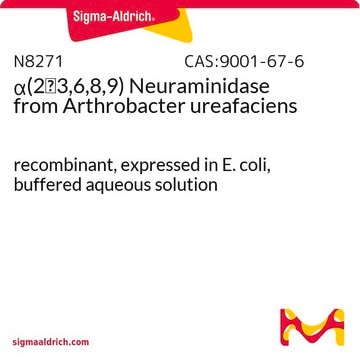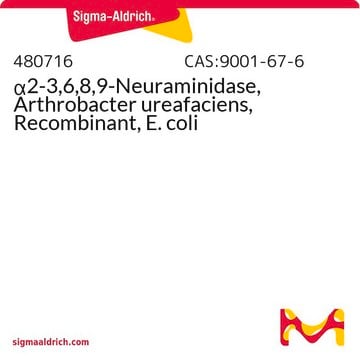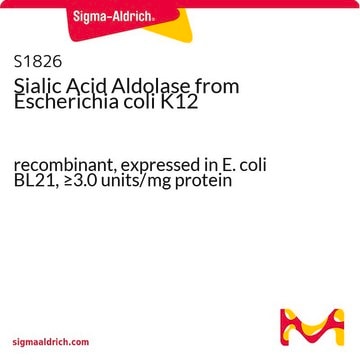N3786
α(2→3,6,8,9) Neuraminidase from Arthrobacter ureafaciens
Proteomics Grade, suitable for MALDI-TOF MS
Synonym(s):
Neuraminidase from Arthrobacter ureafaciens, Acyl-neuraminyl Hydrolase, Sialidase
Sign Into View Organizational & Contract Pricing
All Photos(1)
About This Item
Recommended Products
form
lyophilized powder
Quality Level
quality
Proteomics Grade
specific activity
≥25 U/vial
suitability
suitable for MALDI-TOF MS
storage temp.
2-8°C
Looking for similar products? Visit Product Comparison Guide
Application
Neuraminidase is an important deglycosylation enzyme capable of cleaving all non-reducing unbranched N-acetylneuraminic and N-glycolylneuraminic acid residues by hydrolysis of α(2→6), α(2→3), α(2→8), and α(2→9) linkages (affinity in the order given). Branched sialic acids may also be cleaved with the use of high concentrations of enzyme and prolonged incubations. Desialylated glycoproteins may then be further characterized by treatment with various exoglycosidases resulting in partial or complete O-deglycosylation. SDS-PAGE and MALDI-TOF MS are typically utilized in purification, structural analysis, and sequencing process. These techniques also remove heterogeneity and charge from the glycoprotein.
Packaging
Provided with 5× concentrate reaction buffer.
Quality
The buffer solution has been specifically formulated to assure maximum enzyme stability and assay sensitivity.
Unit Definition
One unit will release 1 nmole of 4-methylumbelliferone from 2-(4-methylumbelliferyl) α-D-N-acetylneuraminic acid per minute at pH 5.5 at 37° C.
Physical form
Lyophilized powder
Kit Components Also Available Separately
Product No.
Description
SDS
- N3536Neuraminidase 5X Reaction Buffer 1.5 mLSDS
related product
Product No.
Description
Pricing
Signal Word
Danger
Hazard Statements
Precautionary Statements
Hazard Classifications
Resp. Sens. 1
Storage Class Code
11 - Combustible Solids
WGK
WGK 1
Flash Point(F)
Not applicable
Flash Point(C)
Not applicable
Certificates of Analysis (COA)
Search for Certificates of Analysis (COA) by entering the products Lot/Batch Number. Lot and Batch Numbers can be found on a product’s label following the words ‘Lot’ or ‘Batch’.
Already Own This Product?
Find documentation for the products that you have recently purchased in the Document Library.
Customers Also Viewed
Natallia Makarava et al.
Acta neuropathologica communications, 6(1), 92-92 (2018-09-14)
Last decade witnessed an enormous progress in generating authentic infectious prions or PrPSc in vitro using recombinant prion protein (rPrP). Previous work established that rPrP that lacks posttranslational modification is able to support replication of highly infectious PrPSc with assistance
Hongyun Li et al.
PloS one, 11(2), e0148238-e0148238 (2016-02-02)
Recent studies have shown that cerebral apoD levels increase with age and in Alzheimer's disease (AD). In addition, loss of cerebral apoD in the mouse increases sensitivity to lipid peroxidation and accelerates AD pathology. Very little data are available, however
Patricia J Campbell et al.
Journal of virology, 88(7), 3802-3814 (2014-01-17)
The 2009 H1N1 lineage represented the first detection of a novel, highly transmissible influenza A virus genotype: six gene segments originated from the North American triple-reassortant swine lineage, and two segments, NA and M, derived from the Eurasian avian-like swine
Tadatsugu Imamura et al.
Journal of virology, 88(5), 2374-2384 (2013-12-29)
Increased detection of enterovirus 68 (EV68) among patients with acute respiratory infections has been reported from different parts of the world in the late 2000s since its first detection in pediatric patients with lower-respiratory-tract infections in 1962. However, the underlying
Alana L Woodward et al.
Veterinary microbiology, 169(3-4), 113-127 (2014-02-01)
Equine influenza viruses are a major cause of respiratory disease in horses worldwide and undergo antigenic drift. Several outbreaks of equine influenza occurred worldwide during 2010-2012, including in vaccinated animals, highlighting the importance of surveillance and virus characterisation. Virus isolates
Our team of scientists has experience in all areas of research including Life Science, Material Science, Chemical Synthesis, Chromatography, Analytical and many others.
Contact Technical Service









